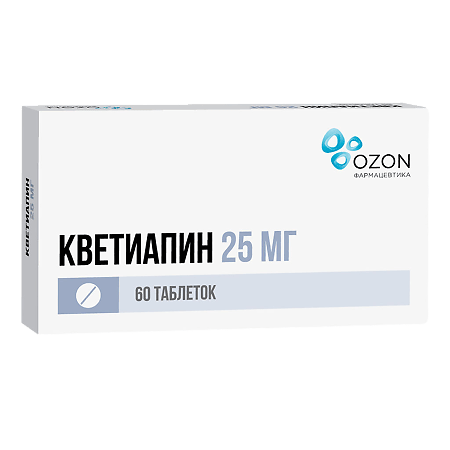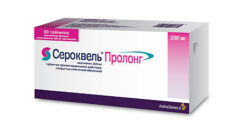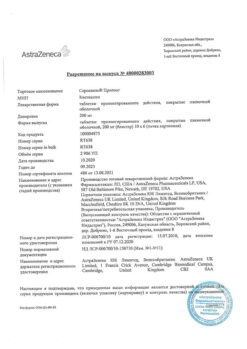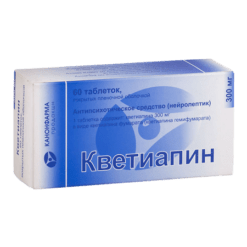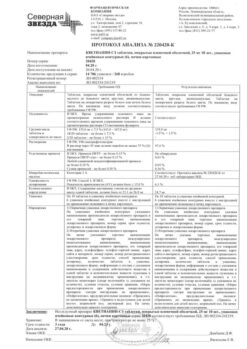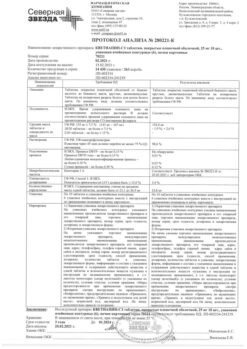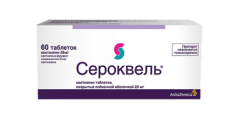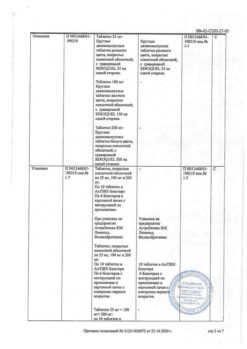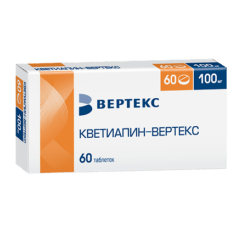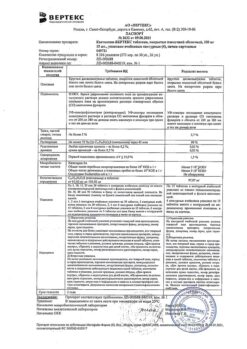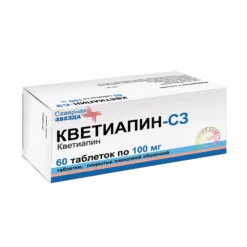No products in the cart.
Quetiapine, 25 mg 60 pcs
€22.32 €18.60
Description
Pharmacotherapeutic group
Antipsychotic (neuroleptic)
ATX code
N05AH04
Pharmacological action
Quetiapine is an atypical antipsychotic. Quetiapine and its active metabolite N-dezalkylquetiapine (norquetiapine) interact with a wide range of brain neutrotransmitter receptors. Quetiapine and N-desalkylquetiapine exhibit high affinity for 5HT2 – serotonin receptors and D1 and D2 – dopamine receptors, which accounts for the major clinical antipsychotic properties of the drug and the low incidence of extrapyramidal side effects.
Quetiapine has no affinity for the noradrenaline transporter and low affinity for 5NT1A , whereas N-dezalkylquetiapine has high affinity for both. Inhibition of the noradrenaline transporter and partial agonism to 5NT1A-serotonin receptors by the metabolite may account for the antidepressant effects of the drug. Quetiapine and N-desalkylquetiapine have high affinity for histamine and α1-adrenoreceptors and moderate affinity for α2-adrenoreceptors.
Quetiapine shows no appreciable affinity for muscarinic receptors, whereas its metabolite N-dezalkylquetiapine shows moderate to high affinity for several muscarinic receptor subtypes. In standard tests in animals, quetiapine exhibits antipsychotic activity. The specific contribution of the metabolite N-dezalkylquetiapine to the pharmacological activity of quetiapine has not been established.
The results of a study of extrapyramidal symptoms (EPS) in animals revealed that quetiapine causes mild catalepsy at a dose that effectively blocks D2 – dopamine receptors. Quetiapine causes a selective decrease in the activity of mesolimbic A10- dopaminergic neurons compared to the A9- nigrostriatal neurons involved in motor function. The incidence of EPS and concomitant use of M-cholinoblockers was comparable to that of placebo when quetiapine was administered with dose titration in schizophrenia. The drug is well tolerated when taken at recommended doses, including in elderly patients. In placebo-controlled studies in elderly patients with dementia, the incidence of cerebrovascular complications when using quetiapine was not higher than in the placebo group.
The drug is effective against both positive and negative symptoms of schizophrenia. Quetiapine is effective as monotherapy for manic episodes of moderate to severe severity. There are no data on long-term use of the drug for prevention of subsequent manic and depressive episodes. There are limited data on the use of quetiapine in combination with valproate or lithium drugs for moderate to severe manic episodes, but the combination was generally well tolerated and the incidence of EPS and concomitant use of M-choline blockers was comparable to that with placebo. Quetiapine is effective at doses of 300 mg and 600 mg in patients with bipolar disorder types I and II of moderate to severe severity. At the same time, the effectiveness of the drug in doses of 300 mg and 600 mg is comparable. Quetiapine is effective in patients with schizophrenia and mania when taken twice daily, despite a half-life of approximately 7 hours. The effects of quetiapine on 5NT2 and D2 receptors last up to 12 hours after taking the drug. In a clinical study in patients with depressive episodes in the structure of bipolar disorder type I and II, the use of quetiapine at a dose of 300 mg per day was more effective compared to placebo in reducing the total score on the MADRS (Montgomery-Asberg Depression Rating Scale. Montgomery-Asberg Depression Rating Scale).
In 4 additional 8-week clinical trials of quetiapine in patients with moderate to severe depressive episodes of bipolar disorder, quetiapine at 300 mg and 600 mg doses was more effective than placebo: mean improvement in MADRS scores and improvement in overall MADRS scores (at least 50%) over baseline values. In a short-term (9-week) study in patients without dementia aged 66 to 89 years with major depressive disorder, quetiapine at doses ranging from 50 mg to 300 mg (the dose was adjusted for clinical response; the average daily dose was 160 mg) reduced depression symptoms compared with placebo. The incidence of EPS and weight gain in stable patients with schizophrenia did not increase with long-term therapy with the drug. In studies of major depressive disorder according to DSM-IV (Diagnostic and Statistical Manual of Mental Disorders (4th ed.)) criteria, no increased risk of suicidal behavior or suicidal ideation was observed when taking the drug compared to placebo. There were no differences in the incidence of extrapyramidal symptoms and concomitant use of anticholinergic medications when using quetiapine at 75-750 mg daily compared to placebo.
Quetiapine does not cause prolonged increases in plasma prolactin concentrations. No differences in prolactin concentrations have been found when using quetiapine or placebo at fixed dose. When quetiapine was used in doses up to 800 mg/day to treat moderate to severe manic episodes both in monotherapy and in combination with lithium or valproate seminary, the incidence of EPS and concomitant use of M-choline blockers was comparable to that with placebo.
. In two short-term (6-week) studies of combination therapy of a depressive episode with quetiapine at a dose of 150 mg/day and 300 mg/day with amitriptyline, bupropion, cipopram, duloxetine,escitalopram fluoxetine, paroxetine, sertraline, or venlafaxine in patients with suboptimal response to antidepressant monotherapy showed improvement in depression symptoms on the Montgomery-Asberg Depression Rating Scale (MADRS). Montgomery-Asberg Depression Rating Scale) (rms change of 2-3.3 points) compared to antidepressant monotherapy.
Indications
Indications
– schizophrenia.
– manic episodes in the structure of bipolar disorder.
– depressive episodes of moderate to severe severity in the structure of bipolar disorder.
Quetiapine is not indicated for the prevention of manic and depressive episodes.
Pharmacological effect
Pharmacological effect
Pharmacotherapeutic group
Antipsychotic (neuroleptic)
ATX code
N05AH04
Pharmacological action
Quetiapine is an atypical antipsychotic drug. Quetiapine and its active metabolite N-desalkylquetiapine (norquetiapine) interact with a wide range of neurotransmitter receptors in the brain. Quetiapine and N-desalkylquetiapine exhibit a high affinity for 5HT2 – serotonin receptors and D1 and D2 – dopamine receptors, which determines the main clinical antipsychotic properties of the drug and the low incidence of extrapyramidal side effects.
Quetiapine has no affinity for the norepinephrine transporter and has low affinity for 5HT1A, while N-desalkylquetiapine exhibits high affinity for both. Inhibition of the norepinephrine transporter and partial agonism towards 5HT1A – serotonin receptors, exhibited by the metabolite, may determine the antidepressant effect of the drug. Quetiapine and N-desalkylquetiapine have high affinity for histamine and α1-adrenergic receptors and moderate affinity for α2-adrenergic receptors.
Quetiapine does not exhibit significant affinity for muscarinic receptors, while its metabolite N-desalkylquetiapine exhibits moderate to high affinity for several muscarinic receptor subtypes. In standard animal tests, quetiapine exhibits antipsychotic activity. The specific contribution of the N-desalkylquetiapine metabolite to the pharmacological activity of quetiapine has not been established.
The results of a study of extrapyramidal symptoms (EPS) in animals revealed that quetiapine causes mild catalepsy at a dose that effectively blocks D2 dopamine receptors. Quetiapine causes a selective decrease in the activity of mesolimbic A10-dopaminergic neurons compared to A9-nigrostriatal neurons involved in motor function. When taking the drug quetiapine with dose titration in schizophrenia, the frequency of EPS and concomitant use of M-anticholinergics was comparable to that when taking placebo. The drug is well tolerated when taken in recommended doses, including in elderly patients. In placebo-controlled studies in elderly patients with dementia, the incidence of cerebrovascular events with quetiapine did not exceed those in the placebo group.
The drug is effective against both positive and negative symptoms of schizophrenia. Quetiapine is effective as monotherapy for moderate to severe manic episodes. There are no data on long-term use of the drug for the prevention of subsequent manic and depressive episodes. Data on the use of quetiapine in combination with valproate or lithium for moderate to severe manic episodes are limited, but the combination was generally well tolerated, and the incidence of EPS and concomitant use of anticholinergic drugs was comparable to that with placebo. Quetiapine is effective in doses of 300 mg and 600 mg in patients with moderate to severe bipolar disorder I and II. Moreover, the effectiveness of the drug at a dose of 300 mg and 600 mg is comparable. Quetiapine is effective in patients with schizophrenia and mania when taken twice daily, although the half-life is approximately 7 hours. The effect of quetiapine on 5HT2 and D2 receptors lasts up to 12 hours after taking the drug. In a clinical study in patients with depressive episodes in the structure of bipolar I and II disorder, the use of quetiapine at a dose of 300 mg per day was more effective than placebo in reducing the total score on the MADRS depression scale (Montgomery-Asberg Depression Rating Scale. Montgomery-Asberg Depression Rating Scale).
In 4 additional 8-week clinical trials of quetiapine in patients with moderate to severe depressive episodes as part of bipolar disorder, quetiapine 300 mg and 600 mg showed greater efficacy compared with placebo: mean improvement in MADRS scores and improvement in MADRS total scores (at least 50%) compared with baseline values. In a short-term (9-week) study in nondemented patients aged 66 to 89 years with major depressive disorder, quetiapine at doses ranging from 50 mg to 300 mg (dose titrated based on clinical response; mean daily dose was 160 mg) reduced depressive symptoms compared with placebo. The incidence of EPS and weight gain in stable patients with schizophrenia does not increase with long-term drug therapy. In studies of major depressive disorder according to DSM-IV criteria (Diagnostic and Statistical Manual of Mental Disorders (4th ed.)), no increase in the risk of suicidal behavior and suicidal ideation was observed when taking the drug compared to placebo. When using quetiapine at a dose of 75-750 mg per day compared with placebo, no differences were found in the incidence of extrapyramidal symptoms and in the concomitant use of anticholinergic drugs.
Quetiapine does not cause a prolonged increase in plasma prolactin concentrations. There were no differences in prolactin concentrations when using quetiapine or placebo at a fixed dose. When quetiapine was used in doses up to 800 mg/day for the treatment of moderate to severe manic episodes, either alone or in combination with lithium or semisodium valproate, the incidence of EPS and concomitant use of M-anticholinergics was comparable to that with placebo.
In two short-term (6-week) studies of combination therapy of quetiapine 150 mg/day and 300 mg/day for depressive episodes with amitriptyline, bupropion, citapopram, duloxetine, escitalopram, fluoxetine, paroxetine, sertraline or venlafaxine in patients with a suboptimal response to monotherapy antidepressant, showed an improvement in depressive symptoms on the MADRS (Montgomery-Asberg Depression Rating Scale) scale (standard change 2-3.3 points) compared with antidepressant monotherapy.
Active ingredient
Active ingredient
Quetiapine
Composition
Composition
Composition per 1 tablet 25 mg:
active ingredient:
quetiapine fumarate – 28.780 mg, equivalent to quetiapine-25,000 mg.
Excipients: microcrystalline cellulose – 60.0 mg; lactose monohydrate (milk sugar) – 44.0 mg; povidone (medium molecular weight polyvinylpyrrolidone) – 9.0 mg; croscarmellose sodium (primellose) – 10.5 mg; magnesium stearate – 1.5 mg
Shell: Opadry II (polyvinyl alcohol, partially hydrolyzed – 2.0 mg; macrogol (polyethylene glycol) 3350 -1.01 mg; talc – 0.74 mg; titanium dioxide E 171 – 1.1333 mg; iron dye oxide (II) yellow E 172 – 0.1167 mg).
Contraindications
Contraindications
• hypersensitivity to any component;
• lactase deficiency, lactose intolerance, glucose-galactose malabsorption;
• simultaneous use with inhibitors of cytochrome P450 isoenzymes, including antifungals – azole derivatives, erythromycin, clarithromycin, nefazodone, HIV protease inhibitors (see section “Interaction with other drugs”).
• psychoses and elderly patients suffering from dementia.
Manufacturer
Manufacturer
Ozon, Russia
Additional information
| Manufacturer | Ozon, Russia |
|---|---|
| Medication form | pills |
| Brand | Ozon |
Other forms…
Related products
Buy Quetiapine, 25 mg 60 pcs with delivery to USA, UK, Europe and over 120 other countries.

